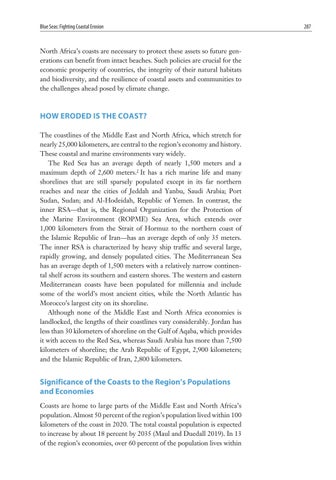Blue Seas: Fighting Coastal Erosion
North Africa’s coasts are necessary to protect these assets so future generations can benefit from intact beaches. Such policies are crucial for the economic prosperity of countries, the integrity of their natural habitats and biodiversity, and the resilience of coastal assets and communities to the challenges ahead posed by climate change.
HOW ERODED IS THE COAST? The coastlines of the Middle East and North Africa, which stretch for nearly 25,000 kilometers, are central to the region’s economy and history. These coastal and marine environments vary widely. The Red Sea has an average depth of nearly 1,500 meters and a maximum depth of 2,600 meters.2 It has a rich marine life and many shorelines that are still sparsely populated except in its far northern reaches and near the cities of Jeddah and Yanbu, Saudi Arabia; Port Sudan, Sudan; and Al-Hodeidah, Republic of Yemen. In contrast, the inner RSA—that is, the Regional Organization for the Protection of the Marine Environment (ROPME) Sea Area, which extends over 1,000 kilometers from the Strait of Hormuz to the northern coast of the Islamic Republic of Iran—has an average depth of only 35 meters. The inner RSA is characterized by heavy ship traffic and several large, rapidly growing, and densely populated cities. The Mediterranean Sea has an average depth of 1,500 meters with a relatively narrow continental shelf across its southern and eastern shores. The western and eastern Mediterranean coasts have been populated for millennia and include some of the world’s most ancient cities, while the North Atlantic has Morocco’s largest city on its shoreline. Although none of the Middle East and North Africa economies is landlocked, the lengths of their coastlines vary considerably. Jordan has less than 30 kilometers of shoreline on the Gulf of Aqaba, which provides it with access to the Red Sea, whereas Saudi Arabia has more than 7,500 kilometers of shoreline; the Arab Republic of Egypt, 2,900 kilometers; and the Islamic Republic of Iran, 2,800 kilometers.
Significance of the Coasts to the Region’s Populations and Economies Coasts are home to large parts of the Middle East and North Africa’s population. Almost 50 percent of the region’s population lived within 100 kilometers of the coast in 2020. The total coastal population is expected to increase by about 18 percent by 2035 (Maul and Duedall 2019). In 13 of the region’s economies, over 60 percent of the population lives within
287






